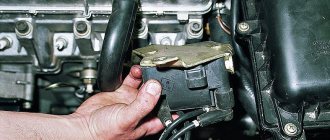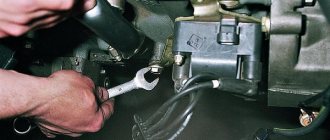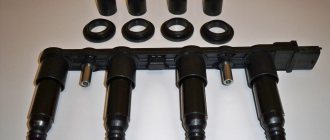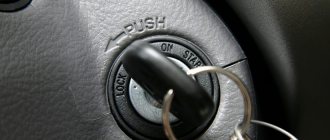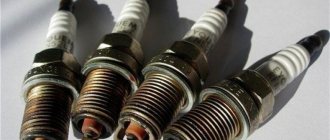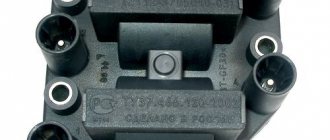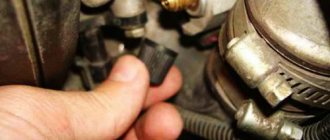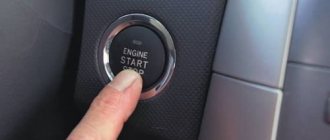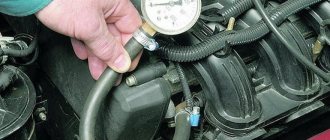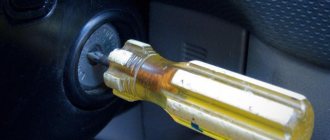Good day!
So, today we will not talk about modifications, but about repairs... Initial data
— there are VAZda six with BSZ. The ignition kit ran faithfully for six years, but nothing lasts forever. The other day, the following problem appeared on the car: — at 2500-3000 rpm, the tachometer needle began to jump. — the car could sometimes stall at XX. — then, when the pedal was sharply pressed to the floor, the car first accelerated, and then began to twitch, the tachometer dropped to zero. I didn’t bother with the speed cut-off, it’s better to let it spin as much as it can rather than cut it off when it’s not necessary! — the dynamics of the car fell, but not critically; it could also be attributed to atmospheric pressure, but this is not entirely true.
The first thing, of course, was to replace the switch, with zero effect. By the way, take a spare switch with you.
In the course of finding out the reasons on another forum (here no one was interested in the post in the forum), several indirect reasons were identified. So, in order (I give the most adequate options):
— Hall sensor: the wire inside the distributor has rubbed against the vacuum corrector lever (due to its operation) and has a short to ground. — With faulty spark plugs, there is a possibility of breakdown of the Hall sensor by high voltage. — This happens because of the coil, and it is advised to change the coil together with the commutator, since a faulty coil can kill the commutator and vice versa. - Py.Sy. One of the signs of problems with the sensor is jumps in the needle in the rpm range of 2500-3000...
There is also a check option:
Check the 12V power to the switch. The reason is sparking. Take time to experiment. Take an insulated wire and be sure to connect it through a fuse (you can use a thin wire, like a “bug” for any fireman) + battery and the power input on the switch. Thus, you will eliminate all intermediate links in the power supply of the ignition circuit (almost in verse). If there are no problems, look for a contact in the power supply: maybe the ignition relay, signaling blocking, terminal connections. Then disconnect the switch and connect instead a load that is obviously large, but not very large, for example. a lamp with parallel filaments near and far from the headlight. The contact will come out in a weak spot (determined by the drop with a voltmeter), and you will localize it by replacing, soldering, stripping, etc. It’s no good to torment yourself and the car with this crap for so long. I hope you can do it, good luck!
There were other options and tips regarding the lid and slider, but they were not justified in my case:
The cover and the slider, if they start to fool around, are not noticeable on the tachometer. Jumps in the tachometer needle are most often interruptions in spark formation, more precisely in the absence of a “signal” from the switch to the coil, and the reason for this is most often in the switch, poor contact in the wiring harness connections or the Hall sensor. The coil is theoretically possible, but it must necessarily be accompanied by jerks, and there will not be strong jumps in the tachometer. Since the switch was changed, we will assume that it is not the problem. Alternatively, I encountered poor contact at the connection point of the wiring harness block and the switch, and only on a warm engine. As far as I remember, one of the contacts of the block “came out” of the socket a little (which is not noticeable under the rubber band) and under certain conditions caused interruptions in the operation of the engine.
The cause of a stalled engine is the spark plugs
In 50% of cases, the problem is due to the fact that the spark plugs simply do not produce a spark. This failure occurs as a result of 3 reasons:
- contacts become clogged;
- plaque forms along the entire contour of the candle;
- malfunction when supplying voltage to the spark plug.
However, the most popular is still black carbon deposits on the spark plugs, which prevents the spark from appearing or causes it to work periodically.
Tip: if the spark plug set malfunctions, you will hear a “triple” sound that is uncharacteristic of the engine. In this case, the car will jerk strongly while moving. As a result, the engine will either stall on its own, or you will need to turn it off and turn the ignition on again.
If you see dirt on the surface of the contacts, this indicates the need to replace a low-quality type of fuel or check the serviceability of the oil supply systems. It is the oil supply adjustment sensors that can splash the spark plugs with it if there is a problem. Also, oil that appears on a set of spark plugs may indicate serious damage to components in the engine cylinders. Be sure to check the engine at a car service center. Otherwise, further operation may lead to expensive replacement of jet rods and even the entire set of pistons.
Information about the design of the starter and its supply wiring
An automobile starter is attached to the engine block and is designed to impart rotation to the crankshaft through a ring gear on the circumference of the flywheel. The main components of the starter:
- An electric motor consisting of a rotor, a stator and a brush unit that powers the rotor windings.
- Freewheel with drive gear (Bendix). This also includes the simplest mechanism that moves the coupling along the shaft.
- Solenoid relay. A powerful solenoid that controls the supply of the clutch and also closes the power contacts of the electric motor.
Two electrical circuits are connected to the starter, a power supply and a control or signal circuit. The first supplies all the energy consumed during operation, and the second serves to turn the device on and off.
Starter operation in normal mode
When the driver gives a command to start the engine, the ignition switch contacts that switch the starter are closed, and voltage is supplied to the control relay.
It is used to unload the contact group of the lock from high currents of the pull-in winding. Sometimes this relay is missing, then the ignition switch is made more massive, capable of switching without being burned by significant currents. After the relay or ignition switch, if it is absent, the signal comes to the control contact of the solenoid relay. Both of its windings are triggered, after which the retractor is excluded from the circuit, and the retainer continues to supply power through the power contacts to the electric motor. At the same time, due to the movement of the solenoid armature, the freewheel engages with the flywheel, imparting rotation to it from the starter. When the engine starts, it throws the clutch back, thereby preventing the starter from “racing” at high uncontrolled speeds. The driver turns off the starter, removing the voltage from the holding winding, the spring returns the solenoid armature to the forward non-working position. Sometimes this is done automatically by control electronics.
The cause of a stalled engine is a power supply failure
In this type of problem, 3 reasons may be involved:
- Poor contact with the terminals of the new battery;
- Detection of poor contact or breakdown along the entire length of high-voltage wires;
- The appearance of malfunctions in the generator or ignition coil system of the car.
If the problem lies in damp high-voltage wires, then it is best to replace them completely along with the battery contacts. If the terminals make poor contact, you need to carefully clean them with sandpaper and try to reconnect them. If the generator is found to be inoperable, the problem usually boils down to problems in the following parts:
- Broken timing belt;
- There is a malfunction inside the housing of the unit itself.
A problem with the generator is easily detected when the corresponding indicator on the dashboard turns on. In addition, if there is insufficient energy supply, the backlight of the on-board panel will gradually fade, and a set of other diagnostic sensors will show incorrect values.
Advice: if when you press the gas the car jerks, then stalls and cannot start, then the problem is related to the failure of the ignition coils. It is best to replace these parts in a car service using special equipment.
From the list of reasons that are directly related to the car engine, you need to move on to problems that arise in the fuel and air supply systems, as well as malfunctions of components responsible for exhaust gas removal.
Dashboard lights go out when you turn the key
If this malfunction occurs, the starter will need to be completely rebuilt. And sometimes even the engine, since a breakdown can be hidden there too. The reason for this behavior is a short circuit in the starter windings. This also happens due to the fact that the crankshaft is jammed and is unable to rotate, or the starter housing is destroyed and the rotor is not aligned. As a result, the car will not start. The reasons lie in the fact that power is supplied to the windings.
If you try to apply voltage to the starter for a long time by turning the key, the contacts will burn out. This will only increase the cost of repairs. The thing is that the positive power wire comes from the pull-in relay directly from the battery. There are no degrees of protection, so when a short circuit occurs, all systems are almost completely shut down. If the starter does not respond to turning the ignition key and the lights go out, then the problem is a short circuit.
Fuel supply faults
It is quite easy to find out that the car stalls while driving due to the engine being “choked” with the fuel mixture - during a long drive you will find that the signal of the sensor responsible for this function is constantly on.
Here the problem lies in low-quality fuel, which does not quickly “ignite” from the spark of the candles. It can also be caused by gasoline not meeting the requirements for the octane number specified in the vehicle specifications. If there are problems with fuel, the gas pedal will be pressed all the way, and the car will not begin to gain speed. In addition, the car will periodically stall when the clutch is engaged.
Another symptom indicating problems with fuel is the appearance of problems with the car after refueling. The problem is characterized by a rapid drop in engine power at full speed, as well as when constantly changing gears. The way out of the situation is to completely drain the bad fuel mixture, wash the engine and all the fuel system pipes.
Also, the car will constantly stall if there is an interruption in the supply of the fuel mixture. This may be due to contamination in the following system components:
- Dirt in the fuel filter;
- Problems with injector nozzles;
- Dirty throttle valves;
- Fuel pump power failure.
What elements need to be changed?
When carrying out a major overhaul of the starter, you need to change almost all of its elements. There is a bronze bushing in the back cover, which helps transfer power to the rotor winding. If not everything, then a lot depends on her condition. With a large gap between the rotor and the bushing, the transmission of electricity occurs much worse, therefore, a large amount of current will be lost.
Replacement of brushes is required. This is the unit that is subject to friction and destruction because of it. On some starter models, this operation cannot be performed, since they are connected to the power supply by soldering. Therefore, if the brush assembly is severely worn, you need to bite off the wires. After this, solder the new brushes into place. Unfortunately, this repair method is not always reliable. If the starter does not respond to turning the ignition key, then it needs to be overhauled. And for this, a new bendix must be installed.
Malfunctions in the air mixture supply system
Here the problem lies either in a clogged air filter or in the failure of the regulator responsible for idling the car. In this case, your car will stall all the time when you gain speed or when you release the gas when you release the accelerator.
To solve the problem, remove and inspect the air filter. If there is serious contamination or chips, replace it. To diagnose and replace the idle speed regulator, you will need the help of qualified car service employees.
How does the engine start?
When the driver turns the ignition key, electric current is supplied to the solenoid relay. It moves the bendix until it engages with the teeth of the engine flywheel and at the same time closes the contacts of the starter itself, causing the crankshaft to rotate.
As soon as the engine cycle starts, the ignition key is returned to the “ignition” position, the bendix is retracted and the gears are disengaged. The mechanical circuit is quite simple, but all its components must work flawlessly, otherwise the engine will not start.
Car exhaust system problem
The engine may also stall if the tubes responsible for removing gases are malfunctioning. At full speed, the car will quickly begin to “choke”, and pressing the gas pedal completely stops the engine. Malfunctions in the operation of the exhaust pipe system in 90% of cases are caused by contamination and clogging of the muffler. However, the catalyst may also fail.
In the first case, carefully clean the muffler and remove foreign objects from there. If there are problems with the catalyst, conduct a complete diagnosis of the exhaust system and replace this element.
Checking the starter and retractor relay
To check, you need to make sure that the battery has a sufficient charge level, the flywheel crown is intact, and the timing belt is not torn. First you need to check if the solenoid relay is working. To do this, disconnect the thin wire from it. Connect an incandescent lamp to it, connect its second terminal to the negative of the battery. When you turn the ignition key to the extreme position, the lamp should light up.
The starter does not respond to turning the ignition key if there is a break in the solenoid relay winding. If the lamp does not light, then look for a fault in the lock. If the lamp is on and the relay core does not retract, then there is a winding break. There is no point in doing repairs; it is easier to replace the retractor completely. To check, you can also short-circuit the two relay terminals using a screwdriver. You just need to do this with the neutral speed on.
What to do if cars with automatic transmission stall?
If your vehicle has an automatic transmission, then the problem should be found in the electrical supply. If you abruptly switch from one gear to another, or while switching gears while braking, the settings may be distorted, and the on-board computer will receive a signal to turn off the engine.
Also, models with automatic transmission may stall due to malfunctions of the hydrodynamic transformers of the gearbox. This problem mainly manifests itself during acceleration and requires urgent intervention from car service specialists.
How to replace the flywheel crown?
This is the most difficult malfunction, since its elimination results in the need to remove the gearbox. Such a process is quite complex. Especially in cases where the box has never been removed or was dismantled a long time ago. Typically, a sign of such a breakdown is a metallic grinding noise that comes from the flywheel. Removing the crown itself and installing a new one takes a little time.
In some cases, you don't even need to purchase a new one. All you have to do is remove the old one, turn it over and put it back in place. But installation may cause some difficulties. First you need to warm the crown over an open fire. After this, it is simply placed on the flywheel. As the metal cools, it contracts and the joint becomes very strong. However, there is nothing to worry about if the car does not start. You already know what to do with the starter and its systems. Don’t forget to carry out maintenance on time, then there will definitely be no “surprises”.
Author:
Maxim Markov
One of the most common car problems is the inability to start the engine. There may be several accompanying signs - when igniting, you can hear clicks in the starter or complete silence, slow rotation of the starter and, accordingly, the crankshaft. There can be quite a few reasons, and they are not always directly related to it. To better understand why the starter does not respond to turning the ignition key, it is necessary to study the engine starting circuit in more detail.
Battery condition
When the battery is discharged, a characteristic sign will be clicking noises from under the hood when trying to start the engine, which is produced by the retractor relay, as well as slow rotation of the crankshaft.
This occurs because with the low voltage supplied by a dead battery, the relay cannot be fully retracted and its core is thrown back by the return spring and the starter clicks. In addition, a low battery will be indicated by dim lights from the side lights and headlights, and after turning the key, the instrument lighting will go out almost completely.
When the battery is normally charged, the voltage at its terminals should be 12-12.4 volts. The voltage is measured with a multimeter. If it is below 11 volts, then starting will be difficult, in addition, the state of charge will not be enough to provide a large starting current.
Starter bushings
Another reason could be worn copper-graphite bushings on which the rotor rests. One of them is pressed into the rear housing cover, where the brushes of the electric motor itself are located, and the front end of the rotor rests on a bushing, which is pressed into a hole in the clutch housing or in the starter housing itself, if the structure is closed.
The first option has almost gone out of use, because the bushing located in the clutch housing quickly breaks, the rotor begins to rotate misaligned and quickly becomes unusable. The second option is widespread almost everywhere, and bushings in this version are much more durable.
However, they also wear out over time and play appears, which eventually leads to jamming.
